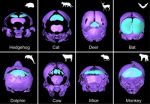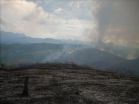These latest Hinode results, to be discussed in a meeting at the University of St Andrews this week (Tuesday 14 August), include new data on the structure of the Sun's coronal magnetic field, obtained whilst studying a violent solar eruption, and the observation of an unusual asymmetry in our star's magnetic field – a finding that could have a significant impact on the behaviour and prediction of the next solar cycle. The new results will be presented by David Long (UCL Mullard Space Science Laboratory) and Masumi Shimojo (National Astronomical Observatory of Japan) respectively.
The Hinode mission is led by the Japanese Aerospace Exploration Agency (JAXA) in collaboration with the UK, USA and European Space Agency. The UK Space Agency funds the operation of the Extreme ultraviolet Imaging Spectrometer (EIS) - a UK-led instrument, building on the UK's long history of pioneering work in solar ultraviolet spectroscopy. The Mullard Space Science Laboratory (MSSL) is the lead institute for EIS, and STFC's RAL Space provided the calibration and observing software.
Louise Harra, UK Principal Investigator for the Hinode EIS instrument and Professor of Solar Physics at UCL Mullard Space Science Laboratory, said, "The latest Hinode results will allow us to probe the Sun's activity both on short time scales of minutes, and on the longer scales of years, both of which are critical to understanding our nearest star."
Solar flares and associated coronal mass ejections have a wide range of effects on technology infrastructure and our day to day lives, potentially disturbing the Earth's magnetic field, knocking-out orbiting satellites and disrupting satellite signals. The impacts are wide-ranging, affecting radio communication, navigation and power systems. With its three advanced and highly sensitive telescopes (visible, X-ray and ultraviolet), the Hinode spacecraft is studying the solar magnetic field at scales smaller than ever before and revealing new information about these colossal explosions in the Sun's atmosphere.
In recent years there have been disruptions to power grids, spacecraft have been lost completely and more than half the Earth orbiting spacecraft were affected in their operation by high energetic particles that bombard the Earth's atmosphere during a storm. We are dependent on spacecraft for everything from navigation to using credit cards, so predicting the impact of such storms is important for a technology- driven world.
The Hinode mission acts as a microscope on the Sun. The instruments onboard probe in detail the generation, transport, and dissipation of magnetic energy from the photosphere to the corona and are recording how energy stored in the Sun's magnetic field is released as the field rises into the Sun's outer atmosphere.
This magnetic field can unleash huge amounts of energy in only tens of minutes. An example of this was observed on the 12th July, where a huge flare exploded on the Sun, leading to disruption to radio communications and a reduction in the power output of a nuclear power station on the east coast of the US. The data from Hinode are being analyzed in order to determine quantitative measurements of the pre-flare Sun to assist in predicting activity.
INFORMATION:
Contact
Julia Short
Press Officer
UK Space Agency
Email: Julia.short@ukspaceagency.bis.gsi.gov.uk
Tel: 01793 418069
Mobile: 07770 276 721
Science contact
Louise Harra
UK PI for the Hinode EIS instrument
UCL Mullard Space Science Laboratory
Email: lkh@mssl.ucl.ac.uk
Tel: 01483 204141
Mobile: 07747 397283
Notes for editors
The UK led Extreme-ultraviolet Imaging Spectrometer (EIS) is a telescope to measure how fast gases travel in the solar atmosphere. It can measure the flows of hot gas down to a level of 1 kilometre per second. EIS is made of very light material – the same type of carbon fibre structure used to build racing cars.
The Mullard Space Science Laboratory is leading the EUV Imaging Spectrometer (EIS) science team.
Through the Science and Technology Facilities Council, the UK has invested almost £5 million in developing and building the EIS.
STFC's RAL Space provided the calibration and observing software. The University of Birmingham was also involved in the build.
The Hinode-6 meeting is an international gathering of scientists to discuss the latest research results from the mission. The conference happens annually and this year it is being held at the University of St Andrews, the first time the meeting is to be held in the UK. The Hinode-6 meeting is supported in part by the UK Space Agency the Science and Technology Facilities Council (STFC) and European Space Agency (ESA).
The UK Space Agency is funding nine PhD students and researchers to attend the conference and participate in the meeting.
UK Space Agency
The UK Space Agency is at the heart of UK efforts to explore and benefit from space. It is responsible for all strategic decisions on the UK civil space programme and provides a clear, single voice for UK space ambitions.
The UK Space Agency is responsible for ensuring that the UK retains and grows a strategic capability in the space-based systems, technologies, science and applications. It leads the UK's civil space programme in order to win sustainable economic growth, secure new scientific knowledge and provide benefits to all citizens.
The UK Space Agency:
Co-ordinates UK civil space activity Encourages academic research Supports the UK space industry Raises the profile of UK space activities at home and abroad Increases understanding of space science and its practical benefits Inspires our next generation of UK scientists and engineers Licences the launch and operation of UK spacecraft Promotes co-operation and participation in the European Space programme
UNIVERSITY OF ST ANDREWS
Founded in the 15th century, St Andrews is Scotland's first university and the third oldest in the English speaking world.
Teaching began in the community of St Andrews in 1410 and the University was formally constituted by the issue of Papal Bull in 1413. The University is currently celebrating its 600th anniversary, due to conclude in 2013.
The University is now one of Europe's most research intensive seats of learning – over a quarter of its turnover comes from research grants and contracts. It is one of the top rated universities in Europe for research, teaching quality and student satisfaction and is consistently ranked among the UK's top six in leading independent league tables produced by The Times, The Guardian and the Sunday Times.
About UCL (University College London)
Founded in 1826, UCL was the first English university established after Oxford and Cambridge, the first to admit students regardless of race, class, religion or gender, and the first to provide systematic teaching of law, architecture and medicine. We are among the world's top universities, as reflected by performance in a range of international rankings and tables. UCL currently has 24,000 students from almost 140 countries, and more than 9,500 employees. Our annual income is over £800 million.
www.ucl.ac.uk | Follow us on Twitter @uclnews
END




